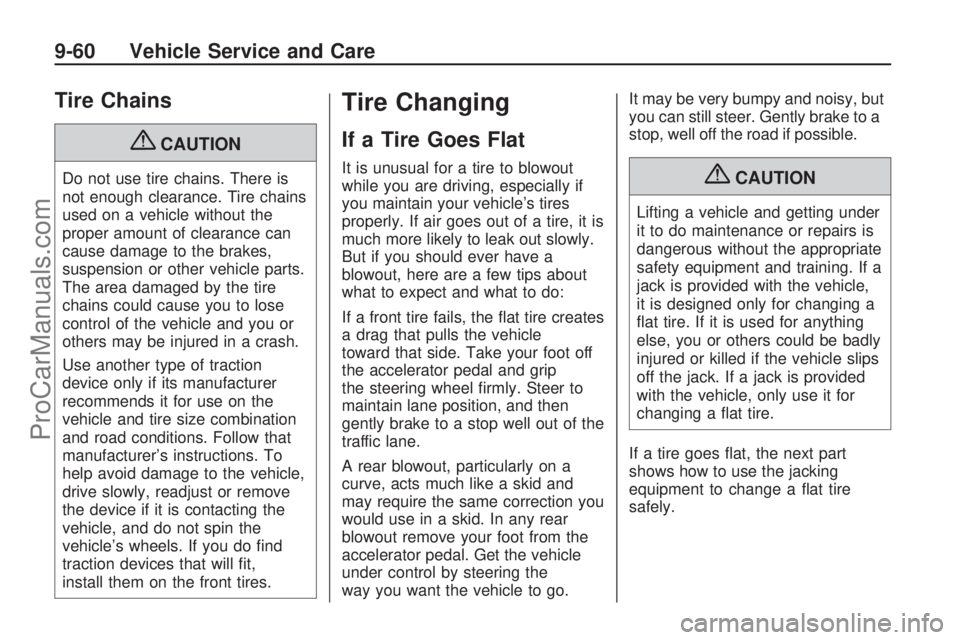traction control SATURN ASTRA 2009 User Guide
[x] Cancel search | Manufacturer: SATURN, Model Year: 2009, Model line: ASTRA, Model: SATURN ASTRA 2009Pages: 314, PDF Size: 1.94 MB
Page 241 of 314

Uniform Tire Quality
Grading
Quality grades can be found
where applicable on the
tire sidewall between tread
shoulder and maximum section
width. For example:
Treadwear 200 Traction AA
Temperature A
The following information relates
to the system developed by
the United States National
Highway Traffic Safety
Administration (NHTSA),
which grades tires by treadwear,
traction, and temperature
performance. This applies
only to vehicles sold in the
United States. The grades are
molded on the sidewalls of
most passenger car tires.
The Uniform Tire Quality
Grading (UTQG) system
does not apply to deep tread,winter-type snow tires,
space-saver, or temporary use
spare tires, tires with nominal rim
diameters of 10 to 12 inches
(25 to 30 cm), or to some
limited-production tires.
While the tires available on
General Motors passenger cars
and light trucks may vary
with respect to these grades,
they must also conform to
federal safety requirements and
additional General Motors
Tire Performance Criteria (TPC)
standards.
Treadwear
The treadwear grade is a
comparative rating based on
the wear rate of the tire
when tested under controlled
conditions on a speci�ed
government test course.For example, a tire graded 150
would wear one and a half (1.5)
times as well on the government
course as a tire graded 100.
The relative performance of tires
depends upon the actual
conditions of their use, however,
and may depart signi�cantly from
the norm due to variations in
driving habits, service practices,
and differences in road
characteristics and climate.
Traction – AA, A, B, C
The traction grades, from highest
to lowest, are AA, A, B, and C.
Those grades represent the
tire’s ability to stop on wet
pavement as measured under
controlled conditions on
speci�ed government test
surfaces of asphalt and
concrete. A tire marked C may
have poor traction performance.
Vehicle Service and Care 9-57
ProCarManuals.com
Page 244 of 314

Tire Chains
{CAUTION
Do not use tire chains. There is
not enough clearance. Tire chains
used on a vehicle without the
proper amount of clearance can
cause damage to the brakes,
suspension or other vehicle parts.
The area damaged by the tire
chains could cause you to lose
control of the vehicle and you or
others may be injured in a crash.
Use another type of traction
device only if its manufacturer
recommends it for use on the
vehicle and tire size combination
and road conditions. Follow that
manufacturer’s instructions. To
help avoid damage to the vehicle,
drive slowly, readjust or remove
the device if it is contacting the
vehicle, and do not spin the
vehicle’s wheels. If you do �nd
traction devices that will �t,
install them on the front tires.
Tire Changing
If a Tire Goes Flat
It is unusual for a tire to blowout
while you are driving, especially if
you maintain your vehicle’s tires
properly. If air goes out of a tire, it is
much more likely to leak out slowly.
But if you should ever have a
blowout, here are a few tips about
what to expect and what to do:
If a front tire fails, the �at tire creates
a drag that pulls the vehicle
toward that side. Take your foot off
the accelerator pedal and grip
the steering wheel �rmly. Steer to
maintain lane position, and then
gently brake to a stop well out of the
traffic lane.
A rear blowout, particularly on a
curve, acts much like a skid and
may require the same correction you
would use in a skid. In any rear
blowout remove your foot from the
accelerator pedal. Get the vehicle
under control by steering the
way you want the vehicle to go.It may be very bumpy and noisy, but
you can still steer. Gently brake to a
stop, well off the road if possible.{CAUTION
Lifting a vehicle and getting under
it to do maintenance or repairs is
dangerous without the appropriate
safety equipment and training. If a
jack is provided with the vehicle,
it is designed only for changing a
�at tire. If it is used for anything
else, you or others could be badly
injured or killed if the vehicle slips
off the jack. If a jack is provided
with the vehicle, only use it for
changing a �at tire.
If a tire goes �at, the next part
shows how to use the jacking
equipment to change a �at tire
safely.
9-60 Vehicle Service and Care
ProCarManuals.com
Page 313 of 314

T
Tachometer.........................4-13
Taillamps....................9-30, 9-32
Theft-Deterrent, Radio...........6-23
Theft-Deterrent Systems......... 2-8
Content Theft-Deterrent....... 2-9
Immobilizer........................ 2-8
Immobilizer Operation......... 2-8
Tilt Wheel............................. 4-4
Tire
Pressure Light..................4-18
Tires..................................9-40
Buying New Tires.............9-54
Chains............................9-60
Changing a Flat Tire.........9-61
Compact Spare Tire..........9-68
Different Size...................9-56
High-Speed Operation.......9-48
If a Tire Goes Flat............9-60
In�ation - Tire Pressure.....9-47
Inspection and Rotation.....9-52
Installing the Spare Tire.....9-63
Pressure Monitor
Operation.....................9-51
Pressure Monitor
System........................9-49
Removing the Flat Tire......9-63Tires (cont.)
Removing the Spare Tire
and Tools.....................9-62
Storing a Flat or Spare
Tire and Tools...............9-66
Tire Sidewall Labeling.......9-42
Tire Terminology and
De�nitions....................9-44
Uniform Tire Quality
Grading.......................9-57
Wheel Alignment and
Tire Balance.................9-58
Wheel Replacement..........9-59
When It Is Time for
New Tires....................9-54
Winter Tires.....................9-41
Towing
Recreational Vehicle..........9-73
Towing a Trailer................9-73
Your Vehicle.....................9-73
Traction
StabiliTrak
®System..........8-19
Transmission
Fluid, Automatic................9-12
Fluid, Manual...................9-12
Transmission Operation,
Automatic.......................... 8-6
Transmission Operation,
Manual............................. 8-9Trip Odometers....................4-13
Turn and Lane-Change
Signals............................. 4-8
Turn Signal/Multifunction
Lever................................ 4-4
U
Uniform Tire Quality
Grading...........................9-57
V
Vehicle
Control............................8-17
Loading...........................8-30
Parking Your....................8-13
Running While Parked.......8-14
Service Soon Light...........4-23
Symbols.............................. iii
Vehicle Data Recording and
Privacy..........................12-16
Vehicle Identi�cation
Number (VIN)...................10-1
Service Parts Identi�cation
Label...........................10-1
Ventilation Adjustment............. 7-4
Visors.................................2-11
INDEX i-9
ProCarManuals.com